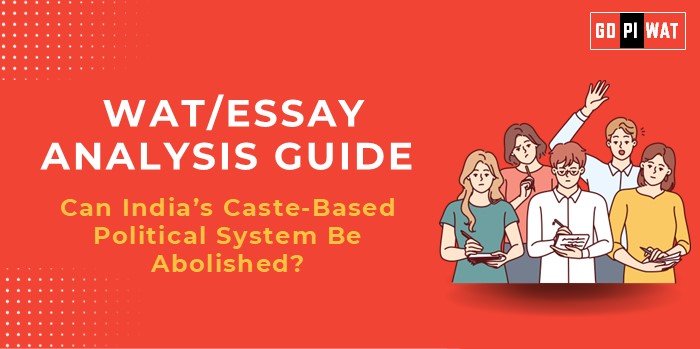🖋️ WAT/Essay Analysis Guide: Can India’s Caste-Based Political System Be Abolished?
🌟 Understanding the Topic’s Importance
Abolishing India’s caste-based political system presents a critical opportunity to transform governance, equity, and socio-economic dynamics. However, the transition demands careful consideration of historical injustices, social empowerment, and future challenges.
📝 Effective Planning and Writing
- Time Allocation:
- ⏳ Planning: 5 minutes to outline key points and statistics.
- ✍️ Writing: 20 minutes to structure and develop arguments.
- 🔍 Review: 5 minutes to refine grammar, coherence, and data accuracy.
- Preparation Tips:
- 📜 Research constitutional provisions for caste-based reservations.
- 📚 Understand historical milestones (e.g., Mandal Commission, SC/ST Reservation).
- 🌍 Compare global systems like affirmative action in the U.S. or socio-economic models in South Africa.
🎯 Introduction Techniques for Essays
- Contrast Approach:
“Despite empowering marginalized groups, caste-based politics often perpetuates social divisions, raising critical questions about its relevance in a merit-based society.”
- Solution-Based Approach:
“Evolving from caste-based to socio-economic criteria for political and policy decisions could address equity while fostering national unity.”
- Historical Lens:
“India’s caste system, rooted in millennia-old societal structures, has evolved into a cornerstone of its political landscape, but modernization demands reforms to ensure inclusive growth.”
🔍 Structuring the Essay Body
- Achievements:
- ✅ Political Empowerment: Over 120 reserved constituencies ensure representation for historically disadvantaged groups.
- 📚 Social Transformation: Reservation policies enabled millions to access education, jobs, and political platforms.
- 💼 Economic Upliftment: Direct economic benefits through public sector representation.
- Challenges:
- ⚖️ Identity Politics: Promotes division and vote-bank politics.
- ❓ Exclusionary Policies: Economically backward but upper-caste groups often remain unaddressed.
- 🚨 Resistance to Change: Deeply entrenched systems face political and societal opposition.
- Future Outlook:
- ✔️ Phased Transition: Gradual implementation of affirmative action based on economic and skill-based criteria.
- 🌟 Unified National Identity: Promote unity through education and public discourse.
💡 Concluding Effectively
- Balanced Approach:
“India’s caste-based political system addressed systemic injustices but requires evolution to accommodate meritocracy and economic fairness in modern governance.”
- Global Comparison:
“By adopting lessons from global affirmative action policies, India can transition to a more inclusive system that balances equity with efficiency.”
📊 Analyzing Successes and Shortcomings
- Achievements:
- ✔️ Greater inclusivity in governance and education.
- 📈 Reduction in socio-economic disparities for reserved groups.
- Challenges:
- 📉 Limited outreach to economically disadvantaged non-reserved groups.
- ⚖️ Perpetuation of caste identities in political decision-making.
- Global Context:
- 🇺🇸 The U.S. shifted from racial quotas to diversity programs.
- 🇿🇦 South Africa integrates socio-economic criteria for fairness and inclusivity.
🚀 Recommendations for Sustainable Progress
- 🔄 Phased Transition: Replace caste-based reservations with economic and skill-based frameworks over time to ensure fairness.
- 📢 Public Awareness Campaigns: Educate citizens on the benefits and objectives of transitioning to equitable affirmative action models.
- 📜 Legislative Reforms: Introduce laws promoting equitable representation without reinforcing caste divisions.
📚 Sample Short Essays
- Balanced Perspective:
“While caste-based politics secured representation for marginalized groups, evolving it into an economic-based system ensures a balanced, inclusive future.”
- Solution-Oriented:
“Replacing caste criteria with socio-economic indicators fosters inclusivity, removes identity politics, and promotes meritocracy.”
- Global Comparison:
“Drawing from South Africa’s socio-economic affirmative action, India can reform its caste-based political system to focus on universal inclusivity.”


